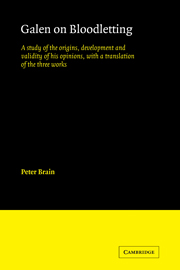 Galen on Bloodletting
Galen on Bloodletting Book contents
- Frontmatter
- Contents
- Preface
- Note on abbreviations and references
- Note on manuscripts and editions
- 1 Galen and his system: an introduction
- 2 Galen's Book on Venesection against Erasistratus (translation)
- 3 Galen's Book on Venesection against the Erasistrateans in Rome (translation)
- 4 Galen's Book on Treatment by Venesection (translation)
- 5 Development of Galen's views and methods as shown in the three works
- 6 Galen, venesection and the Hippocratic Corpus
- 7 Galen's practice of venesection
- 8 Galen's revulsive treatment and vascular anatomy
- 9 The testimony of other writers and the validity of Galen's opinions on sites for venesection
- 10 Galen's use of venesection as an evacuant: can it be justified? A medical digression
- 11 Conclusion
- Glossary
- Works cited
- Index
8 - Galen's revulsive treatment and vascular anatomy
Published online by Cambridge University Press: 04 August 2010
- Frontmatter
- Contents
- Preface
- Note on abbreviations and references
- Note on manuscripts and editions
- 1 Galen and his system: an introduction
- 2 Galen's Book on Venesection against Erasistratus (translation)
- 3 Galen's Book on Venesection against the Erasistrateans in Rome (translation)
- 4 Galen's Book on Treatment by Venesection (translation)
- 5 Development of Galen's views and methods as shown in the three works
- 6 Galen, venesection and the Hippocratic Corpus
- 7 Galen's practice of venesection
- 8 Galen's revulsive treatment and vascular anatomy
- 9 The testimony of other writers and the validity of Galen's opinions on sites for venesection
- 10 Galen's use of venesection as an evacuant: can it be justified? A medical digression
- 11 Conclusion
- Glossary
- Works cited
- Index
Summary
In Galen's own time, some proponents of venesection believed that it was immaterial which vein was opened, since the same effect could equally well be obtained by using any of them; others, Galen among them, thought that it made a great deal of difference which vessel was used. Hippocrates and the most celebrated physicians, he says, were of this opinion also. This is not an isolated opinion of Galen's; he expresses it in all three of his works on venesection, and he makes further mention of specific sites for bloodletting in the De Sanitate Tuenda, the De Methodo Medendi, Ad Glauconem de Methodo Medendi, and his commentary on the Aphorisms. Now Galen was an expert anatomist, and his view of the structure (as distinct from the function) of the vascular system was, except in insignificant detail, that of the anatomist of today; yet he approved of practices of revulsive phlebotomy which, it would seem, must be quite inconsistent with such a view of vascular anatomy. To try to understand why he did this it will be necessary to summarise not only his own anatomical opinions, but also those of some of his predecessors, particularly those who offered clear accounts of the peripheral vessels.
Since the vessels contain blood, and since blood has been a subject of interest to man from the earliest times, we find some reference to blood-vessels in the earliest Western literature. Homer describes how Antilochus, leaping on Thoon from behind, cut right through the vein that runs straight along the back till it arrives at the neck.
- Type
- Chapter
- Information
- Galen on BloodlettingA Study of the Origins, Development and Validity of his Opinions, with a Translation of the Three Works, pp. 135 - 144Publisher: Cambridge University PressPrint publication year: 1986


